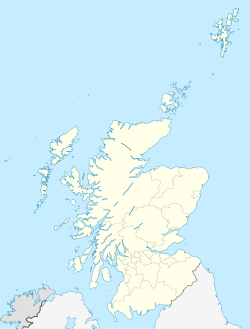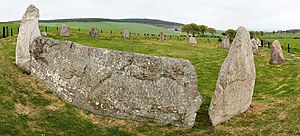Easter Aquhorthies stone circle facts for kids
 |
|
| Location | Aberdeenshire, Scotland |
|---|---|
| Coordinates | 57°16′37″N 2°26′44″W / 57.27702°N 2.44557°W |
| Type | Stone circle |
| History | |
| Periods | Neolithic / Bronze Age |
| Site notes | |
| Ownership | Historic Environment Scotland |
| Website | https://www.historicenvironment.scot/visit-a-place/places/east-aquhorthies-stone-circle/ |
The Easter Aquhorthies stone circle is a very old and special place in north-east Scotland. It is located near the town of Inverurie. This stone circle is one of the best examples of a "recumbent stone circle." This means it has a very large, flat stone lying down, with two tall stones standing next to it.
What makes Easter Aquhorthies extra special is that all its original stones are still standing. It's one of the few circles like this where no stones have fallen over and needed to be put back up.
Contents
About Easter Aquhorthies Stone Circle
The circle sits on a gentle hill about 1.6 kilometers (1 mile) west of Inverurie. It has a ring of nine stones. Eight of these stones are grey granite. One stone is a reddish jasper. Two more grey granite stones stand next to the large, flat "recumbent" stone. This recumbent stone is red granite with shiny crystals and lines of quartz.
Why the Stones Are Special
The people who built this circle used different colored stones on purpose. This is called polychromy. They placed the reddish stones on the south-southwest side. The grey stones are on the opposite side. This shows they thought carefully about how the circle looked.
Archaeologists think there might have been a cairn (a pile of stones) in the middle of the circle. They found a possible cist (a stone box) covered by a capstone there. Today, only a small bump remains in the center.
How the Circle Is Shaped
The ring of stones is not perfectly round. It looks a bit "squashed." It measures about 18.4 meters (60.4 feet) across one way. It is 18.1 meters (59.4 feet) across the other way.
Like other stone circles in this area, the stones get taller as you go around. There is a low stone on the north-northeast side. The tallest stones are the "flankers" on the south-southwest side. These flanker stones are about 2.5 meters (8.2 feet) tall. The large recumbent stone is about 3.8 meters (12.5 feet) long and 1.4 meters (4.6 feet) high.
The recumbent stone is lined up with the southern moonset. This means it points to where the moon sets in the south. It lines up with the nearby Hill of Fare. Two other large stones support the recumbent stone. They stick out into the circle.
History of the Stone Circle
The name Aquhorthies comes from a Scottish Gaelic word. It means "field of prayer." This might mean the area has been a special, holy place for a very long time. Perhaps it was important to the Stone or Bronze Age builders and later to Gaelic people.
Changes Over Time
In the late 1800s, the area around the circle was changed. A small fence and wall were built around it. A stone wall, called a "roundel," was built around the circle between 1847 and 1867.
The circle became more famous in the 1870s and 1880s. Many artists drew and painted it. Some descriptions were a bit wild. For example, Christian Maclagan thought the circle was part of a broch (an old stone tower).
In 1884, a famous archaeologist named Augustus Pitt Rivers became interested in the circle. Five years later, his assistants visited the site. They measured, drew, and photographed it. They even built a small model of the circle. This model is now in The Salisbury Museum in Wiltshire.
Preservation and Discoveries
In 1900, Fred. Coles found the circle in excellent condition. It was protected from farm animals. No bushes were growing around it. He made a very detailed survey of the site.
However, the circle became very overgrown in the early 1900s. George Browne visited in 1920 and said it was "filled with a forest of whin bushes as high as our heads."
The government recognized it as an ancient monument in 1925. In 1963, the State took over its care. In 1985, the stones were cleaned. This was done so that copies could be made for an exhibition. The cleaning showed new details in the stones' colors.
Later studies also found that the circle had interesting sound properties. It's not clear if this was true before the central stone pile (cairn) was removed. It's also unknown if the roundel wall, which might have used stones from the cairn, changed the sounds.




